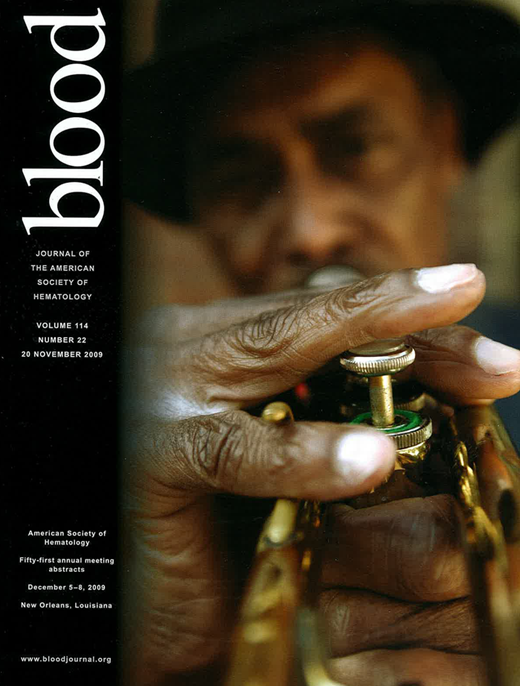Abstract
Abstract 3455
Poster Board III-343
Acute lymphoblastic leukemia (ALL), one of the most common malignancies in childhood, is a heterogeneous disease with individual leukemia subtypes differing in their response to chemotherapy. Recent findings suggest that disruptions of B cell receptor (BCR) signalling pathways may be involved in the development of ALL. The transcription factor PAX5 is essential for the commitment of lymphoid progenitors to the B-lymphocytic lineage. In 30% of childhood B-ALL cases, PAX5 is a frequent target of aberrancies, showing monoallelic loss, point mutations, or chromosomal translocations, whereas the role of these aberrancies is still poorly understood. Using high resolution SNP-chip analysis, we have recently identified several candidate partner genes fused to PAX5 in pediatric ALL, ETV6 (TEL), FOXP1, AUTS2, C20orf112, which bind to PAX5 recognition sequences as strongly as wild-type PAX5 (wt PAX5) suppressing its transcriptional activity in a dominant-negative fashion. In order to study the role of PAX5/TEL in leukemic evolution of B-ALL, we transfected the leukemic BCP cell line Nalm 6, which endogenously expresses PAX5, with a retroviral vector encoding PAX5/TEL and confirmed its expression by Western blotting and RT-PCR. Previously, the fusion gene PAX5/TEL has been cloned into the retroviral vector pMSCV-IRES-GFP (MIGR) from a patient diagnosed with B-cell precursor ALL (BCP) with t(9;12)(q11;p13). This fusion product consists of the 5′-end NH2 terminal region of the PAX5 gene and the almost whole sequence of the TEL gene. PAX5/TEL-MIGR expressing cells were sorted for GFP and analyzed by gene expression profiling on Affymetrix HG-U133 plus 2.0 Array in comparison to cells transfected with vector control (MIGR) and a MIGR vector encoding wt PAX5 (wtPAX5/MIGR). The probes were normalized with the Affymetrix MAS5.0 software. Probes were considered to be differentially expressed with a fold change ≤ 2 or ≥ 2, respectively. We identified a set of about 200 genes that were differentially expressed in the PAX5/TEL expressing cells, most of which were downregulated, compared to the controls. A subset of these genes encodes proteins important for BCR signalling: RAG1, one of two key mediators in the process of V(D)J recombination, VPREB3, which is involved in the early phase of pre-BCR assembly, the Runt domain transcription factor Runx1 (AML1) and FOXP1. The latter two genes are fusion partners of PAX5 in pediatric B-ALL and loss of FOXP1 leads to impaired DH–JH and VH–DJH rearrangement. Additionally, we found BACH2, which plays an important role during B-cell development, as well as protein kinase C-epsilon (PKCe) to be downregulated. PKCe is highly expressed in B cells linking the BCR to the activation of mitogen-activated protein kinases (MAPK). We confirmed the downregulation of the affected genes by RT-PCR. Strikingly, VPREB3 expression showed a significant downregulation of up to 170-fold, and RAG1 up to 90-fold. Loss of the RAG1/2 locus has been found in four precursor B-cell ALL cases, which indicates that defects in this process might contribute to leukemogenesis. We also detected a significant decrease in the expression of wt PAX5 as well as its direct downstream target CD79A (mb-1). CD79A (mb-1) encodes the B cell receptor component Ig-a and its early B cell-specific mb-1 promoter is a target for regulation by early B cell-specific transcription factors like E2A, early B cell factor (EBF), and PAX5. The latter is important for the activation of the mb-1 promoter by recruiting Ets proteins through protein-protein interactions. We investigated the binding efficiency of wt PAX5 to the promoter region of CD79A by chromatin-immunoprecipitation (ChIP). For the ChIP assay, we used a PAX5 antibody detecting the C-terminal region of PAX5 so that the antibody can bind the wt PAX5 but not the fusion product PAX5/TEL of which the C-terminal side is fused to TEL. Binding of wt PAX5 to the promoter region of CD79A was diminished by expression of the PAX5/TEL-fusion protein compared to the controls, leading to repression of CD79A, which we also confirmed by RT-PCR.
In conclusion, we show that the expression of PAX5/TEL in a leukemic cell line has a repressor function on the expression of wt PAX5 as well as other genes important in BCR signalling. Also, we demonstrated that PAX5/TEL has a negative impact on the binding affinity of one of the direct downstream target genes of wt PAX5. Our results indicate a repressor role of the fusion gene PAX5/TEL including BCR signalling and point towards its contribution to leukemic transformation.
No relevant conflicts of interest to declare.
Author notes
Asterisk with author names denotes non-ASH members.

